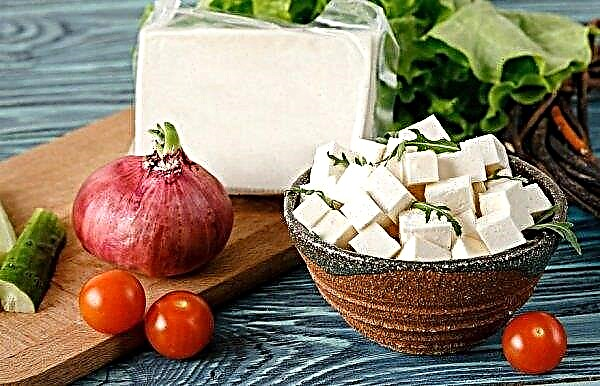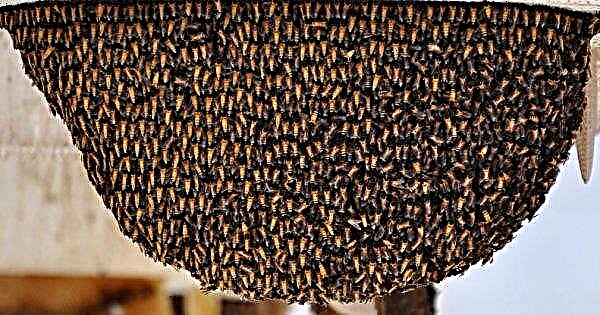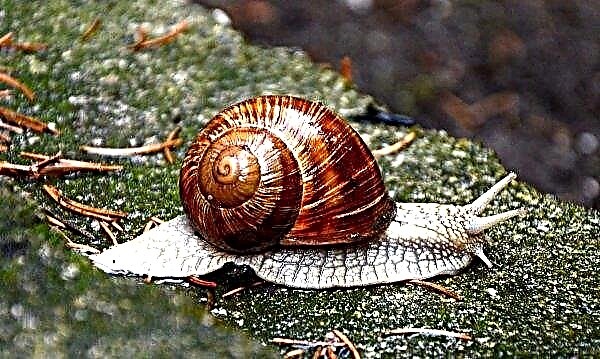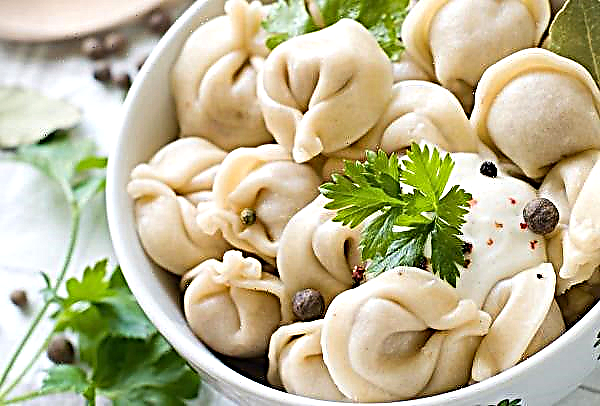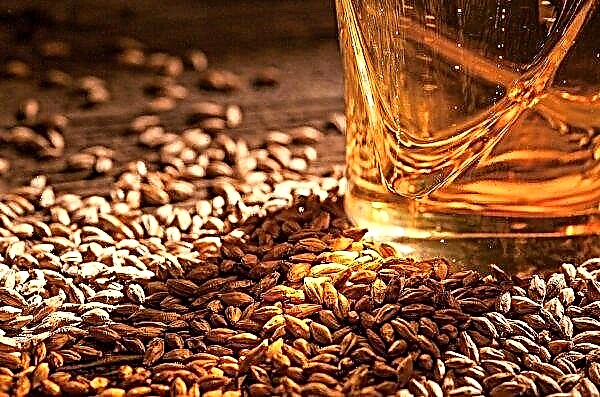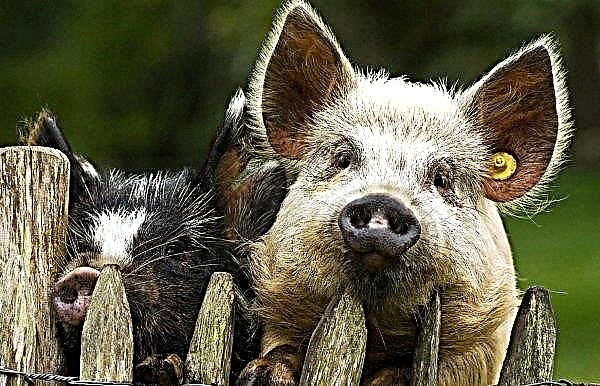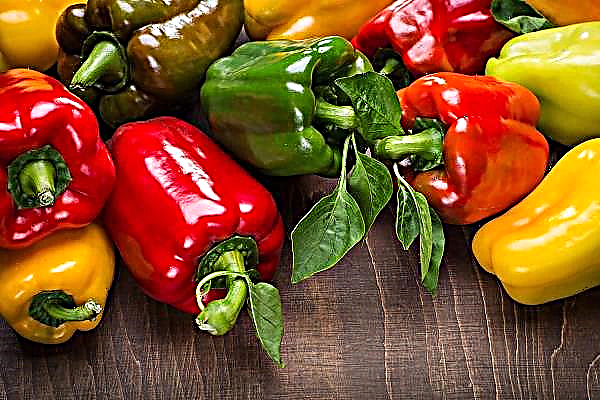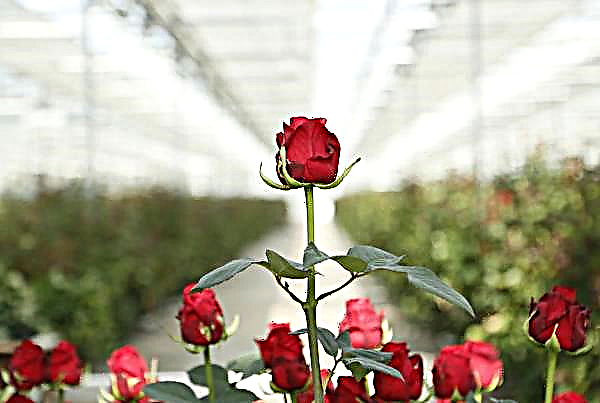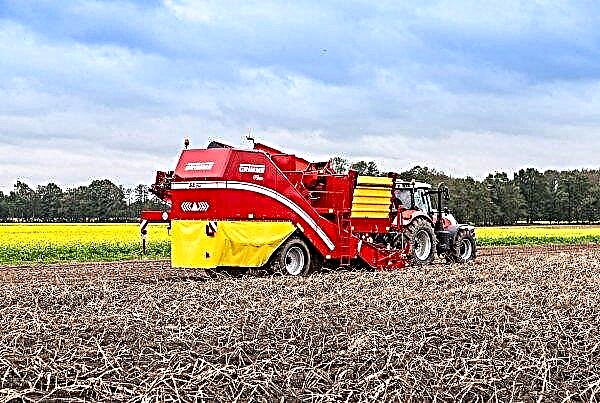Currently, breeders are breeding more and more varieties of different crops. Take into account the shortcomings of the "ancestors", trying to eradicate them, as well as strengthen and consolidate the positive qualities of a particular variety. The result is varieties that satisfy both producers (small farms and large farms) and the consumer. One of these is the relatively young variety of Ramona potatoes.
Description and characteristic
Ramona variety was bred in the early 90s of the twentieth century. And already in 1994 he was introduced to the State Register of the Russian Federation. The originator of the variety is Agrico, a company registered in the Netherlands.
Ramona bushes are quite tall, upright, with an abundance of green mass. The bush grows quickly; during flowering, flowers of red and lilac shades are formed. One bush brings up to 16-20 tubers with a total weight of 7.5-9 kg.
In more detail it is necessary to stop on the description of tubers:
- tubers are pink in color, oval or round;
- size - medium and large;
- the mass of one tuber is 75-100 g;
- the flesh has a creamy tint and a fairly dense structure;
- solids content - 16-18%;
- starch - 14-17%.
Taste qualities
Experts evaluate the taste of this variety at 4.6-4.7 (the maximum number of points is 5). After cooking, it does not darken (regardless of the method of heat treatment), it is well-digested. It can be used to prepare all possible dishes, the composition of which includes potatoes.
Important! One of the characteristic features of the Ramona variety is its tendency to degenerate. This circumstance requires periodic updating of planting material.
Ripening period and productivity
Ramona is a mid-season variety; its vegetation period is 80-100 days. Starting from about 120-125 days, the stage of withering begins. The average yield is about 10-15 tons per hectare, however, under certain favorable conditions, including weather, and using modern agricultural techniques and top dressing, you can get a crop and 25-30 t / ha.
Advantages and disadvantages
- Among the advantages of Ramona, which should be noted, the following should be highlighted:
- has an excellent presentation, tubers of approximately the same size and shape;
- with appropriate care and favorable weather conditions, in the southern latitudes you can count on 2 crops per season;
- grows well on any soil;
- the variety tolerates transportation and storage, does not germinate for a long time;
- a dry summer for potatoes of this variety is not a problem.
- Of the shortcomings, significant, perhaps, only two:
- in the initial stage of growth, the formation of tubers does not differ in intensity;
- yields could be better.
Planting and growing varieties
Activities for planting and growing potatoes Ramona, are not much different from the same work with other varieties. However, there are still some nuances, we will discuss them in more detail below.
Optimal landing times
Landing times vary by region. You should focus on the soil temperature: when the fertile layer warms up to +6 ... + 8 ° C at a depth of 10-12 cm, you can start planting in a prepared soil. Depending on latitude, it can be March in the south and until mid-April in the northern regions.
There are several ways to determine the readiness of the soil for planting:
- Dig a hole with a depth of 14-17 cm, take a lump of earth from the bottom of the hole, throw it on solid ground. If the lump has disintegrated into parts, you can plant it, if only it gets stuck - early, if it crumbles, you need to plant it as soon as possible.
- Swipe the plowed ground with a rod. If the earth crumbles, you can plant it, if there remains a crushed groove - early.
- Focus on the air temperature: during the day it should rise to + 14 ° C and above, and at night should not fall below + 5 ° C.
Keep in mind that the short-term frosts of Ramone are not terrible, she tolerates them quite well in the soil (up to -5 ° C).
Crop rotation rules
When choosing a site for planting, one should remember about the rules of crop rotation: due to observing this simple but very effective agrotechnical technique, you can significantly increase the yield without additional fertilizing.
For potatoes, good crops are such crops:Did you know? With the deterioration of climatic conditions and a decrease in the duration of summer, larger tubers must be used to plant potatoes. That is, if in the southern regions of Russia and throughout Ukraine, tubers weighing 70-80 g are quite acceptable for planting, in the northern regions the minimum mass of planting material should be at least 100 g.
- legumes;
- early cabbage;
- cucumbers
- siderates.
Acceptable cultivation after:
- root crops;
- cabbage;
- greens;
- onions and garlic.
And after the vegetables listed below, potatoes do not grow well:
- Tomatoes
- pepper;
- eggplant;
- potatoes.
Soil requirements
The best type of soil for planting potatoes is a light, loose substrate, rather sandy than clay, best of all, slightly acidic sandy loam or loam (pH 5.1-6.0). Acidic or alkaline soil culture is absolutely not suitable.
You can check the acidity using the leaves of bird cherry, do it as follows:
- Brew 4-6 leaves of the plant in 200 ml of boiling water, cool.
- After cooling, throw a lump of earth into a glass.
- After 2 minutes, consider the color of the infusion: red - acidic, green - slightly acidic (the best option for potatoes), bluish - neutral pH.
However, if the site you selected does not correspond to the recommended soil type, do not despair: you just have to make a little more work. By applying appropriate fertilizers and fertilizing (more on this below), it is quite possible to achieve the desired result.
The place should not be shaded, it is desirable to be on a slight elevation, with a low occurrence of groundwater. Potatoes need to be planted early enough, and in the lowlands, due to melting snow, the soil remains moist for quite some time.
It is advisable that from the north the landing site be fenced with high vegetation (trees, shrubs). Such a combination is not common, so it will be easier to plant some shrub (hawthorn, turn) from the northern side, around the perimeter.Important! Acidity can be checked without analysis, focusing solely on the weeds that are most common on the site. It is advisable to plant potatoes where dandelion, clover, coltsfoot and wheat grass grow.
After a suitable site has been found to eliminate the likelihood of diseases, all plant residues are removed, and the site is treated with a 0.3% solution of copper sulfate. Copper-based fungicides can be used (against late blight). During spring preparatory work, immediately before planting, treat the soil with a solution of TMTD, according to the instructions.

Preparing planting material
For 20-25 days before the intended planting, the tubers are taken out to an open place, well lit by the sun. The tubers are evenly laid out and kept for 8-10 hours daily. In this case, you must try to provide a sufficiently high humidity (80-90%).
Large tubers are cut into pieces so that each of the resulting pieces contains 2-3 sprouts. For planting, a material is suitable whose sprouts have reached 1 cm in length. Before planting, tubers are treated with ash and growth stimulants.
Landing technology
If heavy clay soils prevail in the place you have chosen for planting, during autumn agricultural work, river sand and ash are added to the substrate. In the early spring, shortly before planting, amofoska, nitrate (ammonia) or urea are introduced, at the rate of 100 g / 10 m². In addition, organic fertilizing (peat, manure) - 10 l / m² will not hurt.
In autumn, when digging, add clay soil, peat and a layer of fertile humus (1 bucket / m²) to the sandy soil in the fall.Did you know? As you know, the family to which the potato belongs is called Solanaceae. The closest relatives of potatoes, as it is not surprising - tomatoes, eggplant, nightshade and tobacco.
In the event that in the future place of the potato rows the peat type of substrate prevails, it is diluted with sand, clay, manure and compost (only fully ripened).
As mineral top dressing, use this solution:
- superphosphate - 30 g;
- potassium sulfate - 15 g;
- ash - 100 g.
The number of components is calculated per 1 m² of area, they should be dissolved in the required volume of water and added with watering. The volume of water depends on the degree of dryness of the soil: if it is dry, you can use more liquid, if normal - less. The average value is 1 bucket. Regardless of the type of soil and planting method (manually, using a walk-behind tractor, etc.), the planting pattern is 0.35-0.4 m between adjacent bushes, and 0.6-0.7 m between rows. In heavy soils, the tubers should be buried by 6–9 cm, in the sandy substrate and sandy loam –– by 8–10 cm. If you live in regions with a dry climate, you should bury the tubers by 12–16 cm, this will help to maintain the required amount of moisture.
Regardless of the type of soil and planting method (manually, using a walk-behind tractor, etc.), the planting pattern is 0.35-0.4 m between adjacent bushes, and 0.6-0.7 m between rows. In heavy soils, the tubers should be buried by 6–9 cm, in the sandy substrate and sandy loam –– by 8–10 cm. If you live in regions with a dry climate, you should bury the tubers by 12–16 cm, this will help to maintain the required amount of moisture.
A few simple tips will help you get a decent potato crop:
- it is advisable to break the ranks, orientating along the east-west line;
- for cultivation, you need to use tubers of pure breed, not subjected to pollination by other varieties;
- tuber weight for planting - 60-80 g;
- along with the tuber, a handful of husks of onions or garlic can be put in the soil, such a simple technique will scare away many insects and nematodes.
Variety care after planting
In general, Ramona does not require any special agricultural techniques, everything is traditional here. We will tell in more detail about fertilizing, watering and weeding.
Fertilizer
During flowering, the plant must be fed with fertilizers containing nitrogen. During the formation of ovaries, an effective method of spraying with a 0.05% solution of copper sulfate or zinc, or boric acid.
Bird droppings are an excellent way of feeding, but they should be handled with care, since too concentrated solution can burn young growth.
To exclude such troubles, the solution must be prepared as follows:
- bird droppings or manure - 3 parts;
- water - 100 parts.
Stir the components well, let it brew for 3 days. The solution is watered basal area, pre-moistened, at the rate of 0.8-1 l / bush. After budding, potatoes are fed with ash and potassium sulfate.
The mixture is made as follows:
- ash - 30 g;
- potassium sulfate - 25 g.
Sprinkle potato rows with the mixture, the specified number is calculated per 1 meter of plantings.
Watering
It is believed that under normal weather conditions, three irrigations are sufficient for potatoes during the growing season.
You should focus on such stages of growth:
- bushes reached 7-10 cm - during this period, watering is necessary for the development of green mass;
- during flowering - helps to increase the number of tubers;
- after the bushes have faded - in order to gain mass of tubers.
If the weather is dry, watering is necessary every 1-1.5 weeks between rows. The drip method of watering potatoes has proved to be quite good. To do this, use a hose with holes (2 mm) located every 30 cm. On one side, the hose is plugged, and on the other, it is connected to a water tank. The hose is placed in the row spacing, transferring it between the rows as the planting is saturated with water.
The drip method of watering potatoes has proved to be quite good. To do this, use a hose with holes (2 mm) located every 30 cm. On one side, the hose is plugged, and on the other, it is connected to a water tank. The hose is placed in the row spacing, transferring it between the rows as the planting is saturated with water.
Did you know? To determine if potatoes need watering, you can in a simple way: dip a straight palm with your fingers in the soil, to the wrist. If the fingertips felt moisture, then watering is not needed, if the earth is dry at such a depth, it is better to water it.
Weeding and hilling
The first time they weed potatoes a week after emergence. During the entire growing season, Ramona should be loosened 4-5 times. Hilling is carried out three times using a walk-behind tractor or by hand. Mulching prevents the spread of weeds.
Diseases and pests of the variety
Ramona is quite resistant to the Colorado potato beetle and potato cancer, virus A and Yn, does not suffer from foliage twisting. There is some immunity with respect to late blight and fusarium.
Among the diseases that are dangerous for this variety, the following should be highlighted:
For the prevention of nematodes, some rules should be observed:
- carefully select tubers for storage and planting, leaving only healthy ones;
- to disinfect garden tools;
- comply with crop rotation rules (this measure is relevant for any disease);
- do not use greenhouse soil in the garden;
- in the fall, do a deep digging;
- before planting, the tubers should be treated with Bulba, Albit, and the site with urea (10 g / m²);
- increase ash resistance to nematodes, superphosphate, potash fertilizers;
- pay special attention to areas where cabbage was grown, since after harvesting, the larvae crumble and remain in the soil.
Copper-based preparations are used to treat plants from diseases and pests, such drugs have proven themselves well:
- Nemabact. Use according to instructions.
- BI-58 or 0.02% mercaptophos solution. Sick plants are sprayed every 6 days.
Important! It should be borne in mind that nematodes are a dangerous parasite. If you find large concentrations of worms in the area, you should contact the appropriate services.
As a prevention of scab, correct crop rotation and the application of acid fertilizing are effective. But organics, especially not completely rotted manure, can cause the development of scab. Fungazil, Aquaflo and other fungicides are used as therapeutic agents.
Features of harvesting and storage of crops
An indicator that the potato is ready for harvest is the degree of dryness of the tops: if it is green, then the leaves have enough chlorophyll for the plant's vital activity (tubers continue to gain nutrients). As soon as the tops begin to turn yellow (usually this is the end of summer or the beginning of autumn) - be aware that this is a signal to harvest.
6-8 days before harvesting, mowing tops. It is necessary to dig out root crops in dry weather, preferably sunny, slightly windy. After digging, the crop is laid out on a tarp or plastic film, on the side of the garden. Thanks to this procedure, the tubers will dry out, the remaining soil can easily be removed without damaging the potato itself.
In addition, staying in the sun, the crop is exposed to natural ultraviolet radiation, which, as you know, destroys a large number of pathogenic microorganisms. This circumstance contributes to a longer storage of the crop.
Then you should carefully inspect the crop, remove diseased, rotten, badly deformed and damaged tubers. Put the remaining potatoes into bags and put them in storage in the cellar (the best option).
In order to keep potatoes in marketable form for as long as possible, you must follow simple rules:- do not mix different varieties, they can differ in terms of keeping quality, and the variety, which under other circumstances can lie until the middle of spring, will begin to deteriorate much earlier due to its proximity to a variety that has poor keeping quality;
- 8-10 weeks after laying the potatoes for storage, inspect it again, discard the spoiled, select the one that needs to be consumed first;
- first use damaged or large tubers;
- leave small potatoes for long-term storage, it will finally mature by the end of winter, not earlier.
In general, Ramona potatoes are a very successful variety. Excellent taste, good presentation, shelf life and transportability - these are the qualities for which he is valued. And the average productivity indicators can be significantly increased, by applying fertilizing, crop rotation and some other agricultural techniques.

